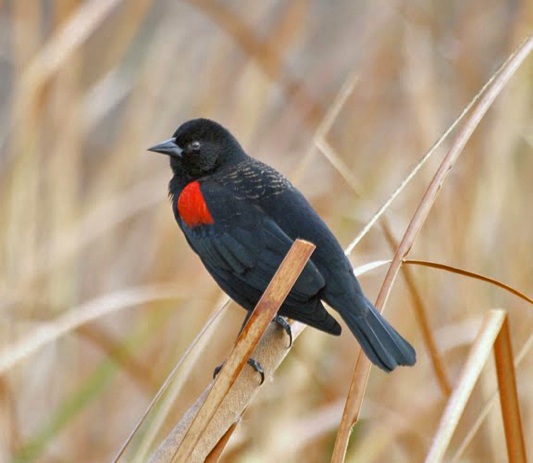A practical guide to bird watching in Sonoma County, California
(Unless otherwise indicated, all phone numbers are in the 707 area code)
A practical guide to bird watching in Sonoma County, California
(Unless otherwise indicated, all phone numbers are in the 707 area code)


Common throughout the county in appropriate habitat. According to at least one source, Red-winged Blackbird is the most common bird in North America (The Birder's Handbook). May form large flocks, sometimes mixed with Brewer's Blackbird or Starlings. Distinctive loud, harsh song that carries long distances--something like conk. la-Reeee! with the end trilled. Also has a sharp call note. Tends to stay near water. Typically seen in marshy areas, near ponds or at the edges of lakes, or around farm ponds. The classic illustration shows a male perched on a cattail.
Red-winged Blackbirds in Sonoma County are generally of the bicolored form--that is they are all black with a red wing patch only. They lack the yellow band below the red patch typical of most populations, although some local birds may have a suggestion of a yellow fringe (see photos below). Males are velvety black with a dark eye and black bill and legs. As noted above, the bright red patches at the shoulders (often referred to as "epaulets") sometimes have a hint of yellow at the lower edge. Red wing patches may be concealed, but should always be visible in flight. In spring, during the breeding season, the patches may be puffed up in display. Juvenile males are a mottled, blackish brown with dull red shoulder patches. Winter birds may show slight golden fringes to body feathers (particularly on the upper back, photo below); these fringes gradually wear off. Females are a streaky brown with a distinct whitish eyebrow and may have a suggestion of pale wing bars, but will have the same silhouette as their male counterparts (especially note the sharp, conical bill). Females may be paler at the throat, sometimes with a beige or pinkish tint there. Female Red-winged Blackbird may resemble a large sparrow, but has a much sharper bill and blackbirds and sparrows behave quite differently.
Similar to Tricolored Blackbird (Agelaius tricolor), but that bird has a darker red wing patch edged with white, and the red patch is frequently hidden, so Tricolored Blackbird often looks all black with a single broad white wing bar. Tricolored Blackbird is present in Sonoma County but far less common than Red-winged Blackbird. Brewer's Blackbird has a purplish-blue tinge to its feathers, no red wing patch, and a pale iris. Brewer's Blackbird will often become semi-tame, hanging around parking lots and picnic areas, while Red-winged Blackbird--although comparatively bold--is more wary, usually sticking to its preferred marshy habitats. European Starling has a rather different silhouette--it's a plumper-looking bird with a stubby tail, a yellow bill, pale legs, and a spotted look in most plumages.
Further reading:
Bolander and Parmeter, Birds of Sonoma County California, rev. ed., 2000, p. 120
Brinkley, National Wildlife Federation Field Guide to Birds of North America, 2007, p. 423
Burridge, ed., Sonoma County Breeding Bird Atlas, 1995, p. 169
Dunn and Alderfer, eds., National Geographic Field Guide to the Birds of North America, 5th ed., 2006, p. 444
Dunn and Alderfer, eds., National Geographic Field Guide to the Birds of North America, 6th ed., 2011, p. 502
Dunne, Pete Dunne’s Essential Field Guide Companion, 2006, pp. 642-644
Ehrlich, Dobkin, and Wheye, The Birder's Handbook, paperback edition, 1988, p. 612
Fix and Bezener, Birds of Northern California, 2000, p. 347
Floyd, Smithsonian Field Guide to the Birds of North America, 2008, p. 460
Kaufman, Field Guide to Birds of North America, 2000, p. 332
Kaufman, Field Guide to Advanced Birding, 2011, pp. 19, 99, 117, 140, 420
Lukas, Bay Area Birds: From Sonoma County to Monterey Bay, 2012, pp. 219, 264-266, 268
Parmeter and Wight, Birds of Sonoma County California, Update (2000-2010), 2012, p. 71
Peterson, Birds of Eastern and Central North America, 5th ed., 2002, p. 312
Peterson, Field Guide to Birds of Western North America, 4th ed., 2010, p. 352
Peterson, Western Birds, 3rd ed., 1990, p. 308
Sibley, Field Guide to Birds of Western North America,1st ed., 2003, p. 440
Stokes, Stokes Field Guide to the Birds of North America, 1st ed., 2010, p. 716-717
Vuilleumier, American Museum of Natural History, Birds of North America: Western Region, 2011, p. 376
Voice: Cornell Lab of Ornithology: All About Birds--Red-winged Blackbird
© Colin Talcroft, 2009, 2010, 2011, 2012, 2013
Unless noted, all photos by the author. If you would like to use one of my images, please ask for permission for non-commercial use with proper credit or commercial use with proper compensation.
Red-winged Blackbird displaying his epaulets

Sonoma County Red-winged Blackbird with red patch showing a hint of yellow below--which is unusual here
Female Red-winged Blackbird
Crane Creek Regional Park, April 2, 2011

For comparison:
Red-winged Blackbird showing the full yellow below the red patch--which is not typical here
(Bird photographed near Woodland, Washington)
Photo: Alan D. Wilson, courtesy of www.naturespicsonline.com



Female Red-winged Blackbird
Place to Play Park, Santa Rosa, May 2, 2012


Red-winged Blackbird, Shollenberger Park, Petaluma, October 31, 2009
Note buff fringes on feathers of upper back
Red-winged Blackbird
Agelaius phoeniceus
1990-2013 Sonoma County data. Graph provided by eBird (www.ebird.org), generated August 4, 2013
EBird-reported occurrence in Sonoma County
Red-winged Blackbird, Las Gallinas Sewer Ponds (Marin County), January 18, 2013
